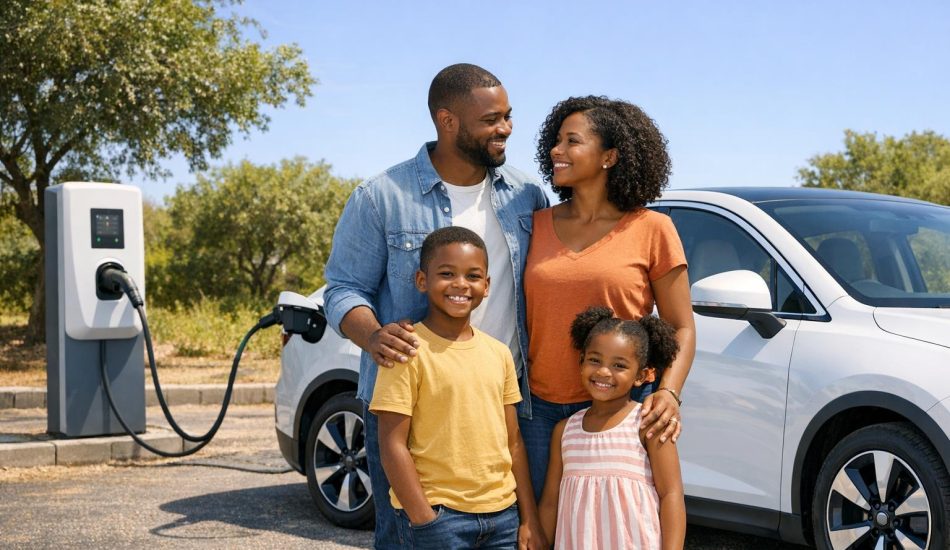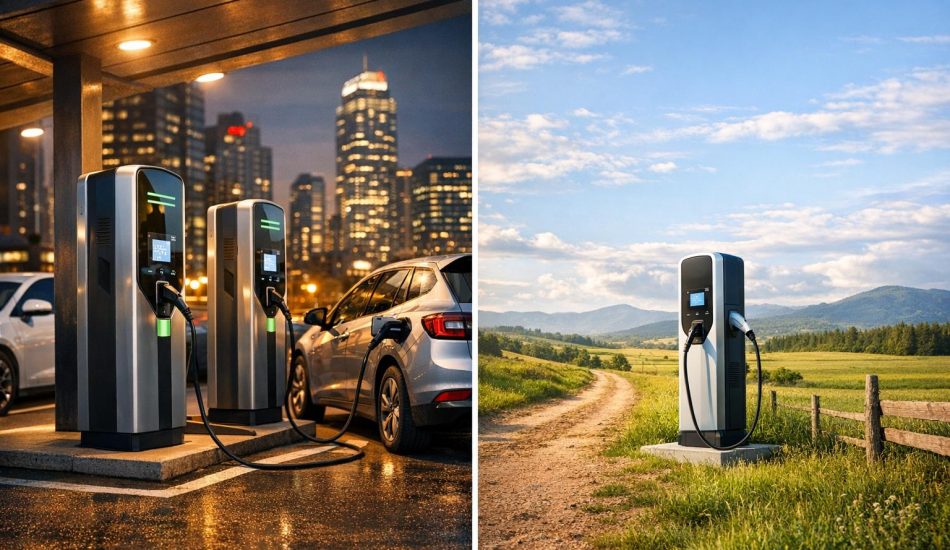
Thinking about how to buy an electric car in Uganda? It’s getting a lot simpler, thanks to a real push from the government and a growing number of suppliers like EV24.africa. People are catching on to the lower running costs and the appeal of cleaner transport, so it's a great time to see what electric options are out there for you.
The Shift to Electric Vehicles in Uganda
Uganda is quickly becoming a serious player in East Africa’s electric mobility scene. This isn't just a fleeting trend; it's a conscious move backed by solid government policies and a clear vision for a more sustainable future. The country isn’t just watching the world go electric – it's actively jumping in.
All this forward momentum is making things much easier for anyone looking to buy. Choosing an EV in Uganda is no longer a niche, difficult decision. It's fast becoming a practical, smart move, with the groundwork being laid now to make owning one simpler and more affordable for everyone down the line.
Government Initiatives Paving the Way
The government's proactive approach has been a huge driver of this change. Uganda's electric vehicle market is growing, largely because of policies designed to encourage clean energy. The National E-Mobility Strategy, which kicked off in 2023, sets some pretty ambitious goals: think transitioning public transport to electric by 2030 and aiming for all vehicle sales to be electric by 2040.
This kind of long-term strategy gives buyers confidence that they’re making a sound investment, knowing that support and infrastructure are part of the plan. Some of the direct benefits we’re already seeing include:
- Reduced Import Taxes: These financial perks make that initial purchase a lot more manageable.
- Infrastructure Growth: There are concrete plans to expand the charging network, which helps tackle one of the biggest concerns for new EV owners – range anxiety.
- Local Assembly: New initiatives are encouraging local assembly, a move that should bring down costs even further.
A Greener Economic Outlook
The move to electric vehicles is tied to a bigger conversation happening all over Africa about sustainability. To really get why this shift is so important, it helps to understand the wider picture of environmental, social, and governance (ESG) factors. For some great perspective on how green initiatives are shaping the continent, you can find valuable insights into ESG and African economies.
This transition fits perfectly with global efforts to slash carbon emissions. For Uganda, a country that already gets most of its electricity from renewable hydropower, charging an EV is dramatically cleaner than burning imported fossil fuels.
This focus on clean energy means that when you buy an electric car in Uganda, you’re making more than just a financial decision; it's a genuinely responsible choice for the environment. You can dive deeper into this topic in our article about https://www.ev24.africa/east-africas-ev-trajectory-rwanda-kenya-uganda-leading-the-charge/.
Finding the Right EV for Your Needs
Alright, let's get to the exciting part: choosing the perfect electric car for your life here in Uganda. It's easy to get lost in all the technical jargon, but the real secret is focusing on what you actually need for our roads and your daily routine. This is where a specialised platform like EV24.africa comes in handy, letting you compare your options without the headache.
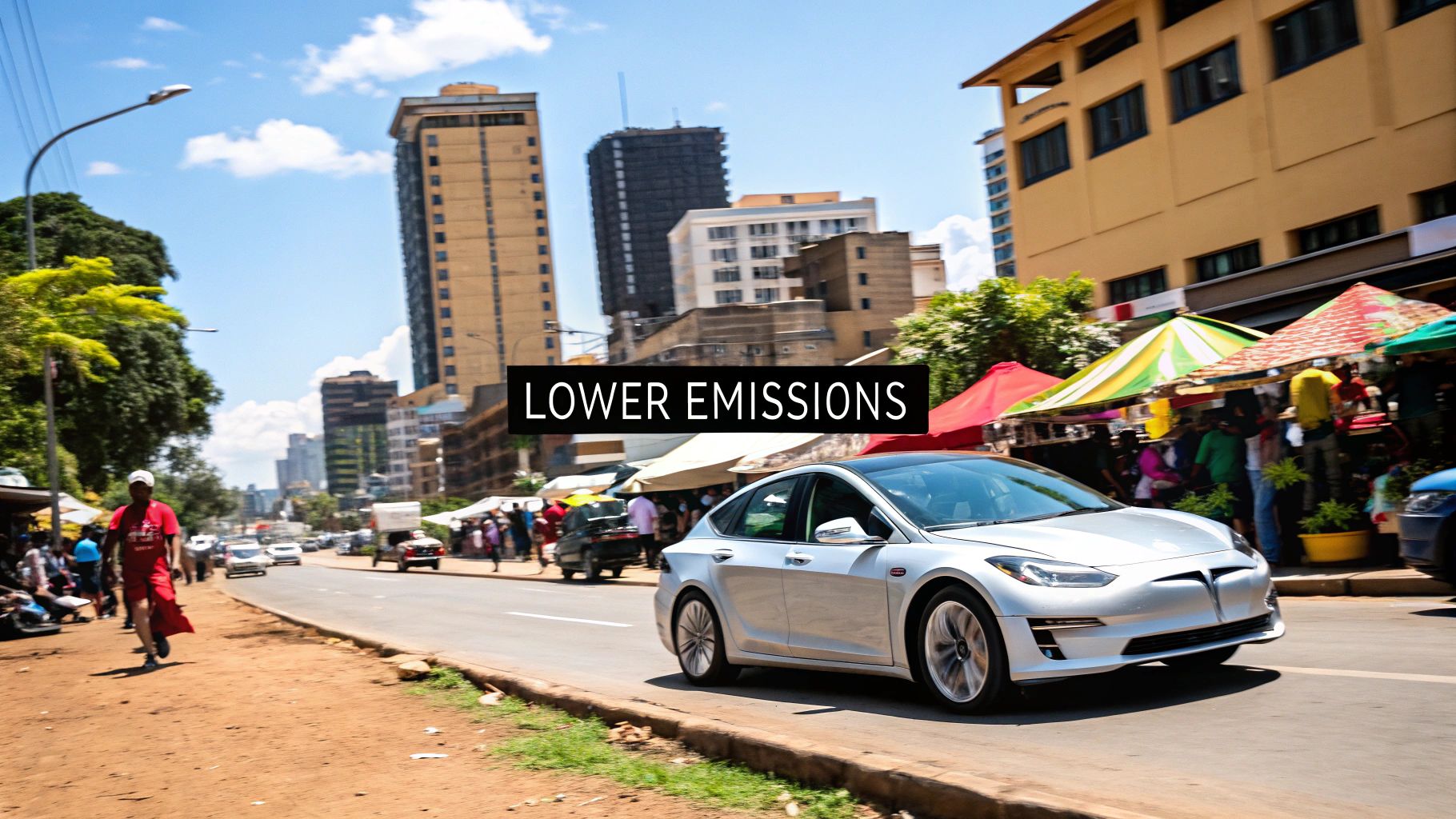
First thing's first, think about your driving. Are you mostly weaving through Kampala traffic, or are you planning regular trips upcountry to places like Mbarara or Gulu? Your answer to that question changes everything.
Match the Car to Your Lifestyle
For someone doing the daily Kampala commute, a nimble hatchback like the Nissan Leaf is a brilliant choice. It’s easy to park, and its range is more than enough for city driving where you’re never too far from a charging spot.
But if you’ve got a family and plan on heading out for long journeys, you’ll want something more robust. An SUV with a bigger battery, giving you over 400 km of range, provides the confidence you need when charging stations are few and far between. No one wants to be worrying about their battery level halfway to their destination.
One of the biggest mistakes I see people make is buying an EV based purely on its maximum range. Be realistic about your average day. Most Ugandans drive less than 50 km daily, so a mid-range EV is often the smartest, most cost-effective option.
Your best friend in this process will be the search filters on a good EV marketplace. They let you cut through the noise and zero in on what truly matters to you.
- Battery Range: Filter for cars that can handle your typical longest drive, whether that's across town or across the country.
- Body Type: Need something for city errands? Look at hatchbacks. Tackling rougher roads or need space for the family? An SUV is your best bet. A sedan offers a great middle ground.
- Price: Set your budget from the start. It saves a lot of time and keeps you focused on cars you can actually afford.
Taking this approach turns a potentially overwhelming search into a straightforward task. When you prioritise your real needs over flashy specs, you end up with an electric car that truly fits your life.
For a deeper dive into this, check out our complete guide to choosing the right EV for your needs in Africa. It's packed with more tips to help you make a smart decision when you're ready to buy an electric car in Uganda.
Getting Your EV Home: The Purchase and Import Journey
So, you’ve found the electric car that fits your life and your budget. Fantastic! Now for the next big step: actually getting it from wherever it is now, all the way to Uganda. This part can feel a bit daunting, but when you work with a service like EV24.africa, what seems like a mountain of logistics becomes a straightforward, step-by-step process.
Let's walk through exactly what happens after you say "yes" to your new EV, from paying for it to seeing it arrive in Kampala.
First Things First: Paying for Your Car
Once you've settled on a vehicle, the first real action is locking it in with a payment. On a trusted platform, you'll be guided through a secure payment system. You’ll get an invoice breaking down the cost of the car and any other immediate fees.
It’s really important to know what you're paying for at this stage. Usually, this initial payment covers the CIF (Cost, Insurance, and Freight). In plain English, that means the price includes the car itself, insurance to cover it while it's on the ship, and the cost of shipping it to the port of entry. For Uganda, that port is almost always Mombasa in Kenya.
A bit of hard-won advice: triple-check that invoice before you send any money. Make sure the Vehicle Identification Number (VIN) is correct, the price matches what you agreed, and the shipping terms are clear. A few minutes of diligence here can save you a world of trouble down the road.
As soon as your payment clears, the seller gets to work on their end. They'll start the process of de-registering the car in its home country and getting it ready to be loaded onto a ship.
The Voyage to Mombasa
Your car's sea journey is the longest part of the wait. Depending on where it’s coming from—often Japan, the UK, or even China—the trip to Mombasa can take anywhere from four to six weeks.
The seller or the platform you're using will manage the booking with the shipping line. They will then send you a crucial packet of documents, either by courier or digitally. You'll need these for the next stage.
Here's what to expect in that packet:
- Bill of Lading: This is the big one. It's your proof of ownership and the official contract with the shipping company. Guard it with your life!
- Export Certificate: This is the official document proving the car was legally shipped out of its country of origin.
- Commercial Invoice: This lists the value of your car. The Uganda Revenue Authority (URA) will use this to calculate the taxes you'll need to pay.
The image below gives a good overview of the approvals process, which is especially relevant if you're looking to take advantage of government incentives for EVs.
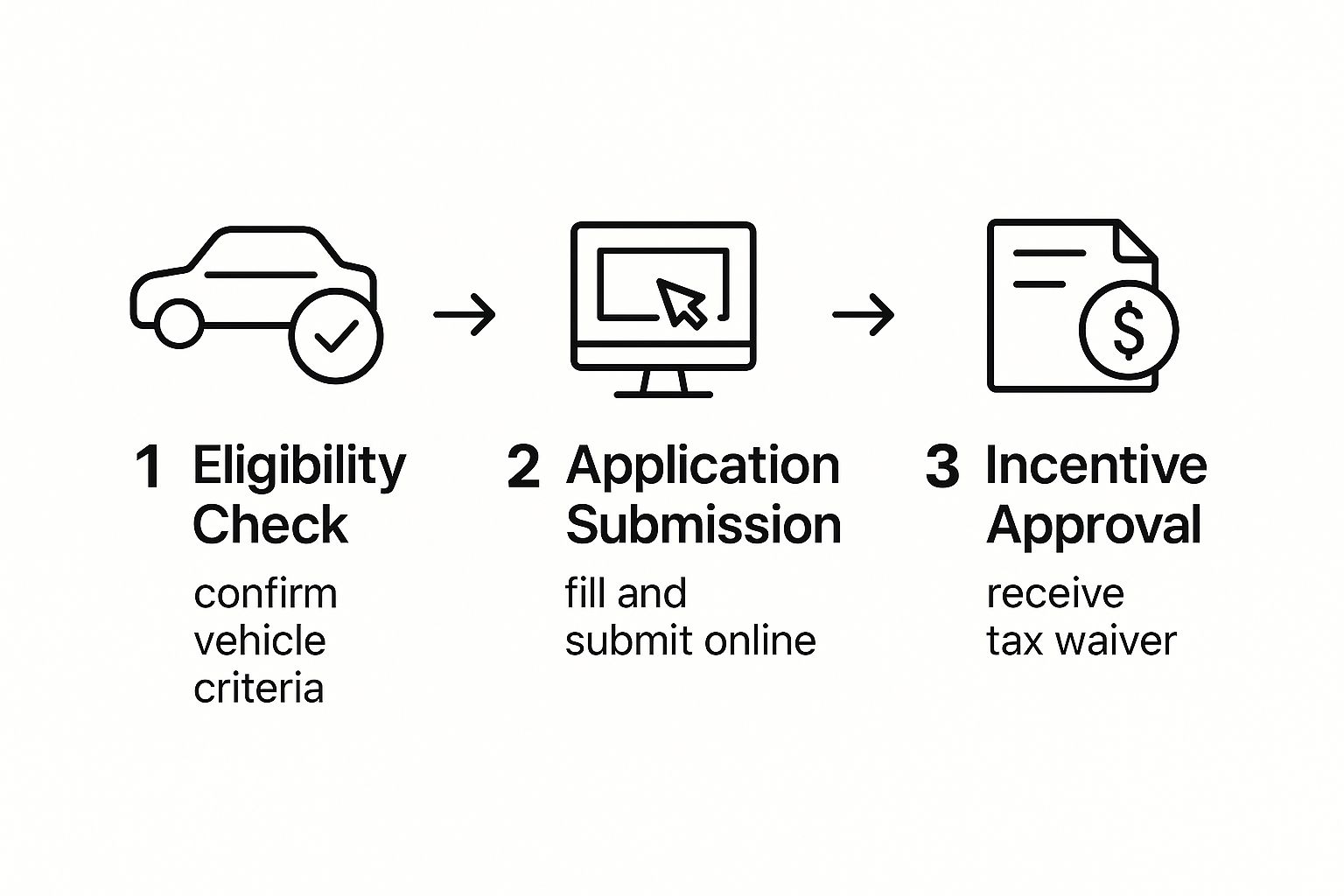
While your car is sailing the high seas, it's the perfect time to line up your team on the ground.
Your Boots on the Ground: The Clearing Agent
This is where a good clearing and forwarding agent becomes your best friend. While your EV is still in transit, you need to hire an agent to handle the complex process of getting your car from the port at Mombasa, through Kenyan and Ugandan customs, and finally to you.
Many great firms can act as both your shipping agent in Mombasa and your clearing agent in Uganda, which makes life a lot simpler.
You'll need to get those original documents to your agent so they can start the customs paperwork. They will file declarations with the authorities, handle port charges for you, and arrange for a car carrier to transport your vehicle from Mombasa to Kampala. Honestly, choosing a reliable, experienced agent is probably the single most important decision you'll make in this entire import process.
Making Sense of Uganda's EV Import Taxes and Duties
Alright, let's talk numbers. This is often the part that feels the most intimidating when you’re looking to buy an electric car in Uganda, but it's really just a matter of understanding the system. The final price you'll pay is a combination of the car's cost and the taxes levied by the Uganda Revenue Authority (URA). Once you see how it's broken down, it’s not so complex.
Everything starts with what’s called the Customs Value, or CIF value. Think of this as the baseline number for all tax calculations. It's the total of what you paid for the car, plus the cost of insurance and shipping (freight) to get it to Mombasa. The URA determines this value, and it’s what they use to figure out your tax bill.
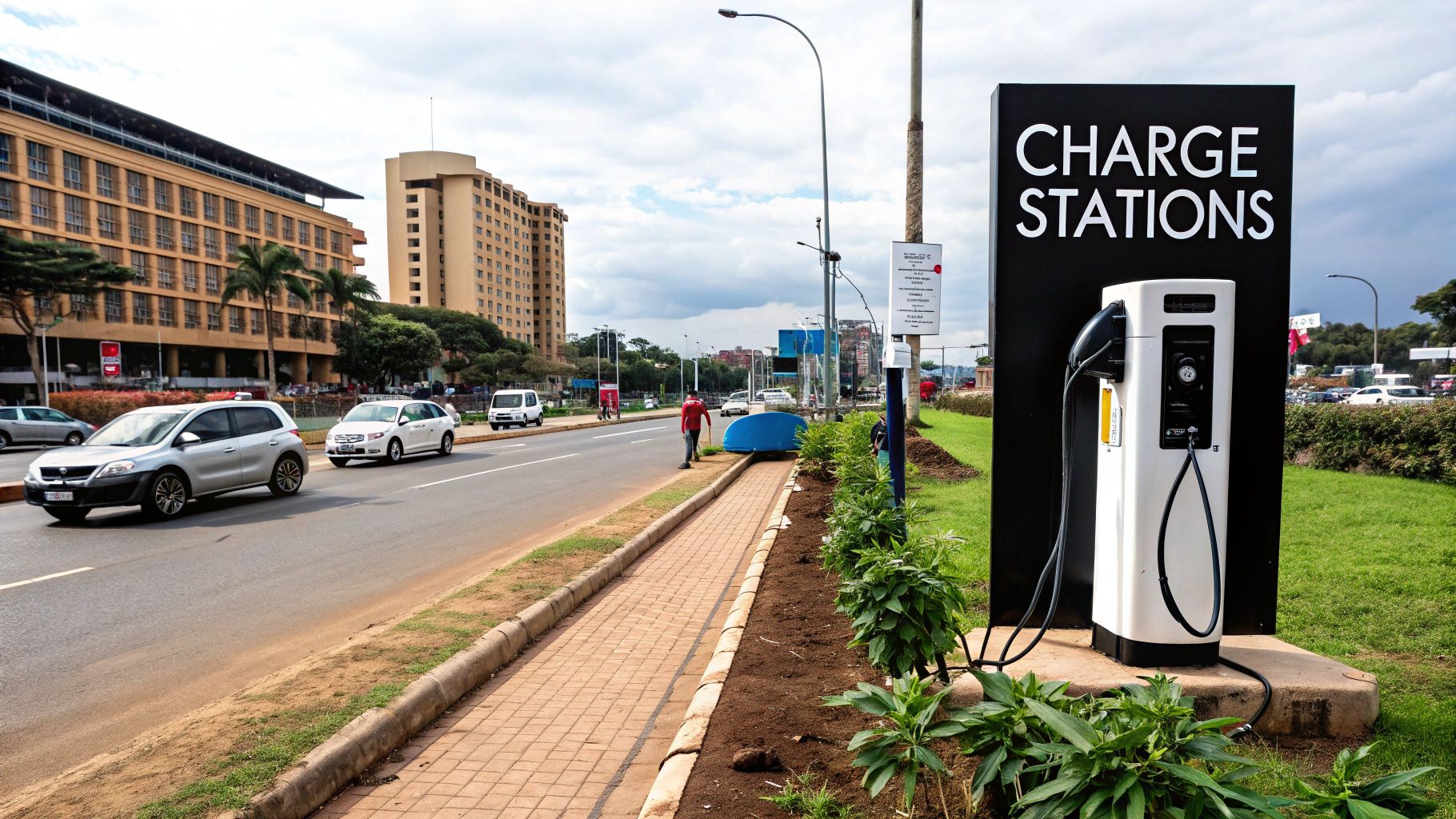
The Main Taxes You'll Encounter
When your EV lands and the CIF value is set, a few specific taxes come into play. Even with government incentives pushing for EV adoption, some standard import levies apply across the board, whether the car is electric or petrol.
Here are the key ones to budget for:
- Environmental Levy: This is a tax specifically for used cars. If your vehicle is between 5 and 10 years old, expect this to be 35% of the CIF value. It’s a standard measure to discourage the import of much older vehicles.
- VAT (Value Added Tax): A familiar tax for most, VAT is a standard 18% consumption tax. It's calculated on the sum of the CIF value plus any other duties, like the Environmental Levy.
- Withholding Tax: This is an advance income tax payment, set at 6% of the CIF value. It's a standard part of the import process for goods of a certain value.
- Registration Fees: This is the one-time cost to get your car officially on the road with Ugandan number plates.
A bit of hard-won advice: Don’t just budget for the sticker price of the car. I've seen many first-time importers get caught by surprise because they forgot about these government charges, which can add a substantial amount to the total cost. Knowing these up front is the key to a smooth process.
A Practical Example of How Taxes Add Up
To put this into a real-world context, let’s run a quick scenario. Imagine you're importing a used electric SUV that's about eight years old, and the URA assesses its CIF value at UGX 55,000,000.
Here’s a sample breakdown of how the taxes would likely be calculated.
Sample EV Import Tax Calculation for Uganda
This table gives a clear illustration of the various taxes and fees for a used EV with a CIF value of UGX 55,000,000.
| Tax/Fee Type | Calculation Basis | Estimated Amount (UGX) |
|---|---|---|
| Environmental Levy | 35% of CIF (UGX 55,000,000) | 19,250,000 |
| Withholding Tax | 6% of CIF (UGX 55,000,000) | 3,300,000 |
| VAT | 18% of (CIF + Levy) | 13,365,000 |
| Registration Fees | Fixed URA fee | ~1,800,000 |
| Total Estimated Taxes | Sum of all above | ~37,715,000 |
Seeing the numbers laid out like this really helps you plan your finances properly and avoid any last-minute shocks.
Of course, policies can change, and there might be specific incentives to consider. For a deeper dive, check out our complete guide on Uganda's EV import policies. While your clearing agent will provide the final, precise figures, having this knowledge beforehand puts you firmly in the driver’s seat.
Getting Your EV Cleared and on the Road
Your electric car has finally arrived in Kampala! Now for the last bit of paperwork: clearing customs and getting it registered with the Uganda Revenue Authority (URA). This is the final step to getting your official number plates and hitting the road. It might seem like a lot of red tape, but it’s actually quite straightforward when you know what to expect.
This is where your clearing agent really proves their worth. They’ll be handling all the filings and dealing directly with the URA, which is exactly why picking a good one from the start was so important. They'll do the heavy lifting for you here.
The Customs Clearance Lowdown
Before the URA gives you the green light, your EV has to go through a physical inspection. A URA officer needs to check the car in person, making sure the Vehicle Identification Number (VIN) and motor number match up exactly with what’s on your import documents. There are no shortcuts here; it's a mandatory check to ensure everything is legitimate.
To keep things moving smoothly, make sure your agent has all the original documents you were sent:
- The Original Bill of Lading: This is the non-negotiable proof of ownership and shipment.
- The Export Certificate: This shows the car was properly de-registered in its country of origin.
- The Commercial Invoice: This shows the car's value, which the URA uses to calculate the final taxes.
After the inspection is done and all the taxes are paid, the URA will issue a release order. Think of this as the official permission slip that allows your car to finally leave the customs bonded warehouse.
Getting Your Ugandan Number Plates
Once the car is released from customs, the very last thing to do is get it registered. Your agent will take all the customs clearance paperwork and use it to apply for your new Ugandan number plates. This is all done online through the URA system and doesn't take long once the previous stages are ticked off.
This is the moment it all becomes real – your car is officially legal and ready for Ugandan roads. The whole process is becoming more common as the country sees a real shift towards electric vehicles. As more Ugandans make the switch to cleaner transport, the system is getting better at handling these new imports, whether they're second-hand from abroad or assembled right here. You can actually read more about these big changes in Uganda's growing automotive market on globalmonitor.us.
A Quick Tip from Experience: Scan or take clear photos of every single document – the Bill of Lading, invoices, tax payment slips, everything. Save them to a cloud service like Google Drive or Dropbox. If a physical paper gets lost in the shuffle, you'll be incredibly glad you have a digital backup.
Your agent will then pick up the new plates and fit them onto your car. They’ll hand you the keys, the original logbook, and a file with all your paperwork. And that’s it! You've done it. Congratulations on becoming a proud EV owner in Uganda
What It's Really Like Living with an EV in Uganda
So, you've brought your new electric car home. Fantastic! But that’s just the starting line. The real adventure is weaving it into your daily routine, and I can tell you from experience, it’s becoming easier and more rewarding every day here in Uganda.
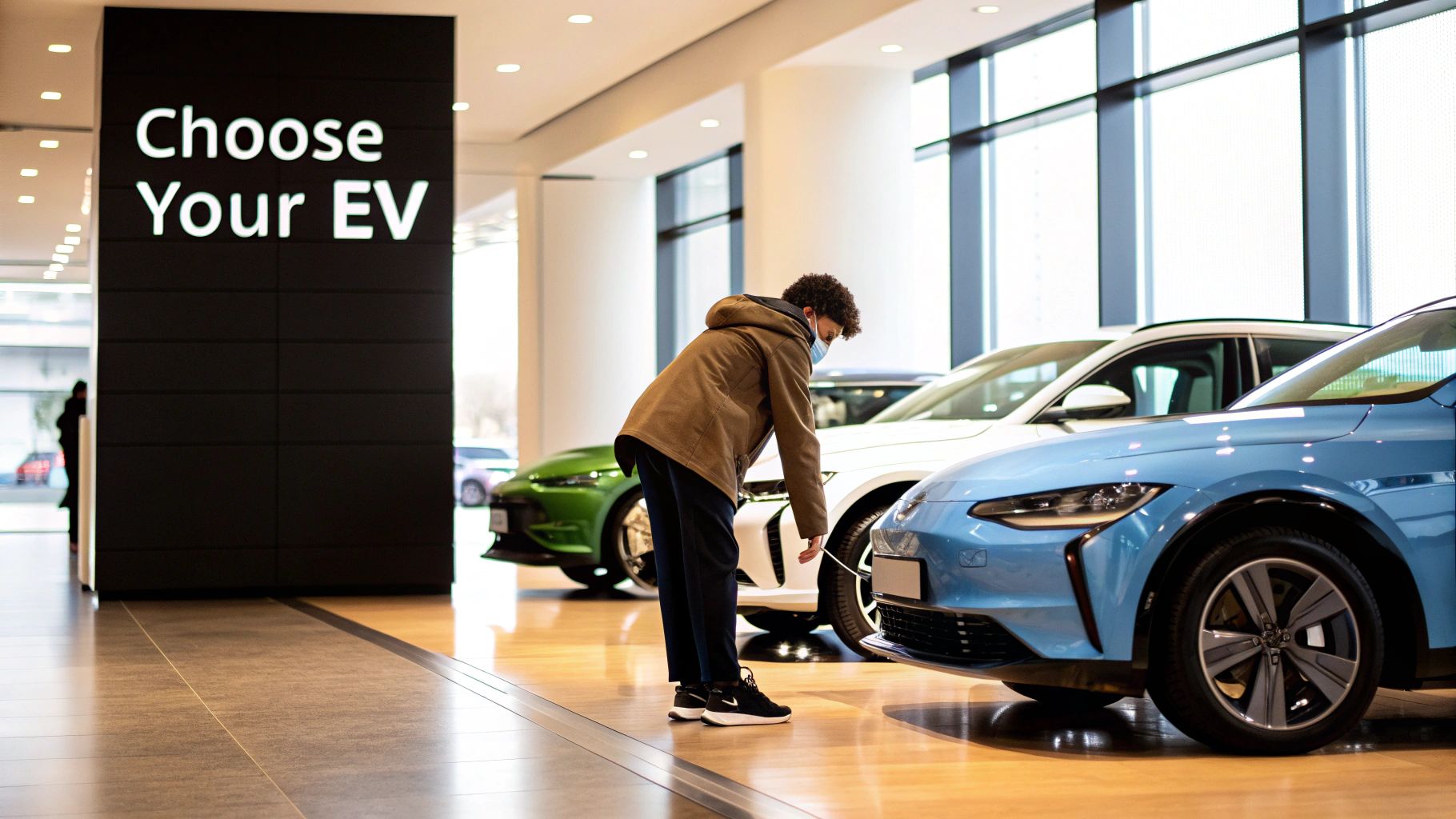
The first question I always get is, "What about charging?" It’s a fair point. While we're seeing more public charging stations popping up beyond Kampala in places like Jinja and Mbarara, the secret to a stress-free EV life is home charging.
Seriously, installing a charger at home changes everything. You simply plug in overnight and wake up to a fully charged car every single morning. For your daily commute and running around town, this completely eliminates "range anxiety." For those longer journeys, a little forward planning with a charging station app is all it takes.
You're Not on Your Own: The Local Support System is Growing Fast
When you buy an EV here, you're not just getting a set of wheels; you're becoming part of a growing movement. The support network for drivers is getting stronger all the time, driven by some incredible local companies who are all-in on electric mobility.
A key player shaping this landscape is our very own Kiira Motors Corporation (KMC). As a state-owned manufacturer, their ambition is huge: they’re gearing up to produce 5,000 electric vehicles annually. This is a massive step forward, making EVs more accessible and affordable for everyone.
Having local assemblers and dedicated EV service centres right here in Uganda is a total game-changer. You’re not left wondering where to go for maintenance. Instead, you have direct access to technicians who genuinely understand the ins and outs of your electric vehicle.
This local network gives you real peace of mind. Knowing that expert help is on hand makes ownership simple and worry-free. And to keep your EV looking as good as it drives on our roads, these essential car washing tips will help you maintain that fresh-from-the-showroom look.
Deciding to buy an electric car in Uganda right now means you're stepping into a well-supported and exciting future. From the convenience of home charging to the expanding public network and robust local industry, the road ahead is electric.


